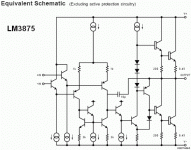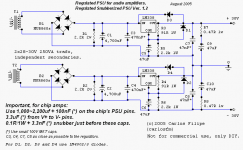beau - Hey I've just been doing that here. Lets compare results.
Device under test - Single LM3886 built up as per carlos schema. 1000uF on each rail near the chip plus snubber. Constructed like a birds nest. Imagine chip on heat sink, flying leads from chip to a piece of PCB where all components are mounted. No tracks on PCB just jumper wires connecting large copper areas where componets are souldered. Kind of point to point/PCB hybrid. With signal and power ground areas.
Power supply - +/-30V from a bench power supply. No idea what capacitors are in there.
current limiting is triggering at 300ma. 50cm long untwisted cables from supply to amp.
Input - Computer CD players headphone output.
Test signal - CD of Laurie Anderson's Bright Red.
Output - An old Mission 761 speaker.
Level - Loud enough that I worry about the neigbors.
Scope - A Philips PM97 50MHz scopemeter on loan from work.
Sound - Sounds just fine to me.
Result - On both +ve and -ve supply pins of the LM3886 I can see Laurie Anderson singing. 80mv peak to peak max.
OK rough and ready, totally unscientific. But now I have something to work on to improve.
Device under test - Single LM3886 built up as per carlos schema. 1000uF on each rail near the chip plus snubber. Constructed like a birds nest. Imagine chip on heat sink, flying leads from chip to a piece of PCB where all components are mounted. No tracks on PCB just jumper wires connecting large copper areas where componets are souldered. Kind of point to point/PCB hybrid. With signal and power ground areas.
Power supply - +/-30V from a bench power supply. No idea what capacitors are in there.
current limiting is triggering at 300ma. 50cm long untwisted cables from supply to amp.
Input - Computer CD players headphone output.
Test signal - CD of Laurie Anderson's Bright Red.
Output - An old Mission 761 speaker.
Level - Loud enough that I worry about the neigbors.
Scope - A Philips PM97 50MHz scopemeter on loan from work.
Sound - Sounds just fine to me.
Result - On both +ve and -ve supply pins of the LM3886 I can see Laurie Anderson singing. 80mv peak to peak max.
OK rough and ready, totally unscientific. But now I have something to work on to improve.
Re: small caps, large caps
You can see the compensation cap in this equivalent schematic of LM3875.
It is 10 pF.
The circuits of LM3886 and LM3875 have identical topology (except for MUTE and some other values of a few resistors)
see my attached schematic of LM3875
heater said:7. Yesterday I found this Analog Devices app note http://www.analog.com/UploadedFiles/Application_Notes/135208865AN-202.pdf containing a disturbing concept.
On page 2 he describes how the compensation capacitor within an op amp is almost directly connected to a power supply rail.
Usually negative.
Totally destroying PSRR at high frequencies.
Not sure if this has much effect at audio frequencies but we sure don't want high frequencies getting in there. The op amps feed back will not help. Good PSU decoupling is essential.
I suggest all budding chip amp buiders read that note anyway as a brilliant insight to grounding and decoupling.
You can see the compensation cap in this equivalent schematic of LM3875.
It is 10 pF.
The circuits of LM3886 and LM3875 have identical topology (except for MUTE and some other values of a few resistors)
see my attached schematic of LM3875
Attachments
Does anybody think that 80mV p-p ripple in the +-30V supply rails of a power amplifier is somewhat to worry about?
Howerver, the test was probably flawed because a regulated bench power supply was likely employed. A transformer and a diode bridge should be used instead, and up to a couple of volts p-p of ripple may be observed at high volumes (in my experience).
Howerver, the test was probably flawed because a regulated bench power supply was likely employed. A transformer and a diode bridge should be used instead, and up to a couple of volts p-p of ripple may be observed at high volumes (in my experience).
As we seem to have attracted prople from everywhere, here it goes again
I tend to post the unregulated PSU because it's simple to build, but this one also gives excellent results.
Notice that I always recommend 2,200uF near the chip, bypassed and snubberized.
Need I say that the PSU voltage is always rock steady? 😀
Bass is TIGHT, fast.
I tend to post the unregulated PSU because it's simple to build, but this one also gives excellent results.
Notice that I always recommend 2,200uF near the chip, bypassed and snubberized.
Need I say that the PSU voltage is always rock steady? 😀
Bass is TIGHT, fast.
Attachments
More than 10 years ago that I started this thread. And I can now admit that my impressions / perceptions of chip amps were wrong. They're pretty damn good...
I'm using composite chip amps (My-Ref FE) i built mono blocks. They are brilliant, best amps i have heard to date.
They're pretty damn good...
They're power opamps, like opamps they respond well to a very low impedance power supply. Unlike opamps the impedance of the load is very low so the supply has to be that much better (at least 100X better) to achieve excellence.
More than 10 years ago that I started this thread. And I can now admit that my impressions / perceptions of chip amps were wrong. They're pretty damn good...
Now what is your opinion of class D IC's? (TPA3116/8, TDA8954, TAS5630, TPA3251/5)
🙂
Well, DUG... I don't really know what to say. I see things moving in that direction and I suppose I'd have to spend some time with these circuits to have an informed opinion. My knowledge of class D is minimal at this stage.
Instinctively though, the simple inability to alter the gain of these amps (for example, other parameters too) would seem to limit the scope for creativity, individualization and connection to other technologies eg tube circuit elements. WHich is to say, I'm not sure how much diy fun they offer?
And why would you need obscene power numbers like these, anyway?
S
Instinctively though, the simple inability to alter the gain of these amps (for example, other parameters too) would seem to limit the scope for creativity, individualization and connection to other technologies eg tube circuit elements. WHich is to say, I'm not sure how much diy fun they offer?
And why would you need obscene power numbers like these, anyway?
S
More than 10 years ago that I started this thread. And I can now admit that my impressions / perceptions of chip amps were wrong. They're pretty damn good...
Wisdom comes with age 😉
More than 10 years ago that I started this thread. And I can now admit that my impressions / perceptions of chip amps were wrong. They're pretty damn good...
Having built all different kinds, non-inverted, inverted and buffered gainclones and published a few designs, the best sounding gainclone by far is when configured as a Trans-Amp and then drive compatible loudspeakers like the Elsinore Mk5 and Mk6 or with fullrange drivers a la Nelson Pass ideas.
Trans-Amp 40 Watt Current Source Amplifier
Current Source and Fullrange by Nelson Pass
Elsinore Mk6 Speakers
When used as a "current source" the sound is on another level again - makes them the most amazing value amp ever - the trick is to find the right speaker that is/are compatible. That throws out commercial designs, but great for the world of DIY. Get stuck into that and you can spend many enjoyable hours, like Nelson must have based on reading his PDF, link above.
.
Indeed.More than 10 years ago that I started this thread. And I can now admit that my impressions / perceptions of chip amps were wrong. They're pretty damn good...
They are so simple (to assemble) that there are fewer mistakes to be made and thus easier to achieve specified performance.
But we still screw them up with incorrectly wired connections.
More than 10 years ago that I started this thread. And I can now admit that my impressions / perceptions of chip amps were wrong. They're pretty damn good...
Over the last 10+ years I've built a few and currently have an Akitika. My perception is that they are quite good.
- Status
- Not open for further replies.
- Home
- Amplifiers
- Chip Amps
- At the risk of offending everyone...

